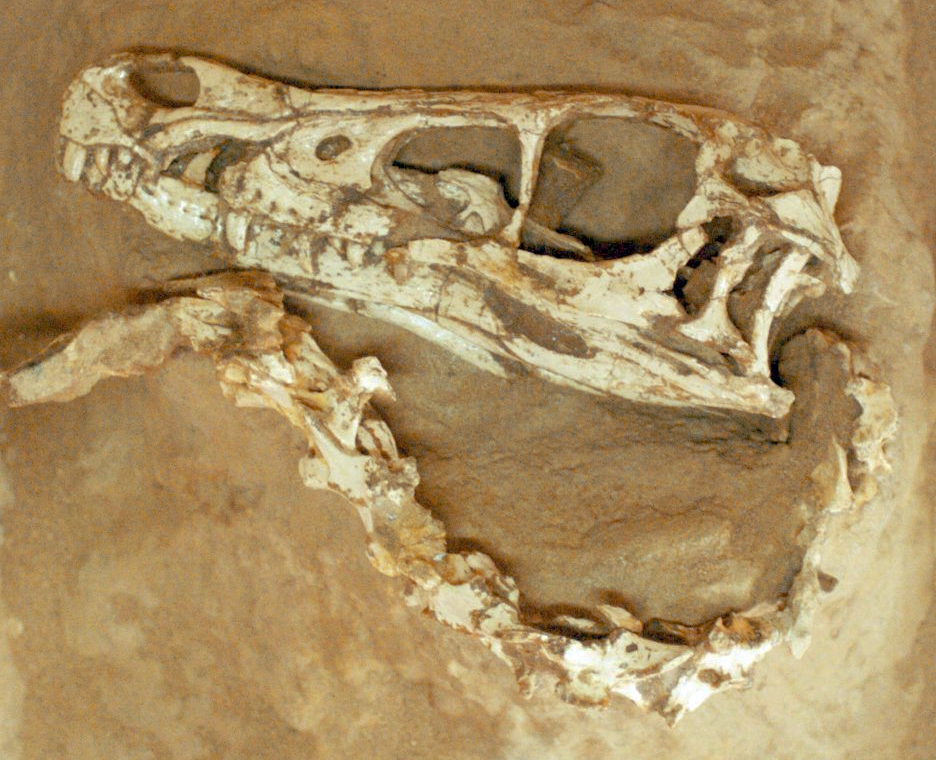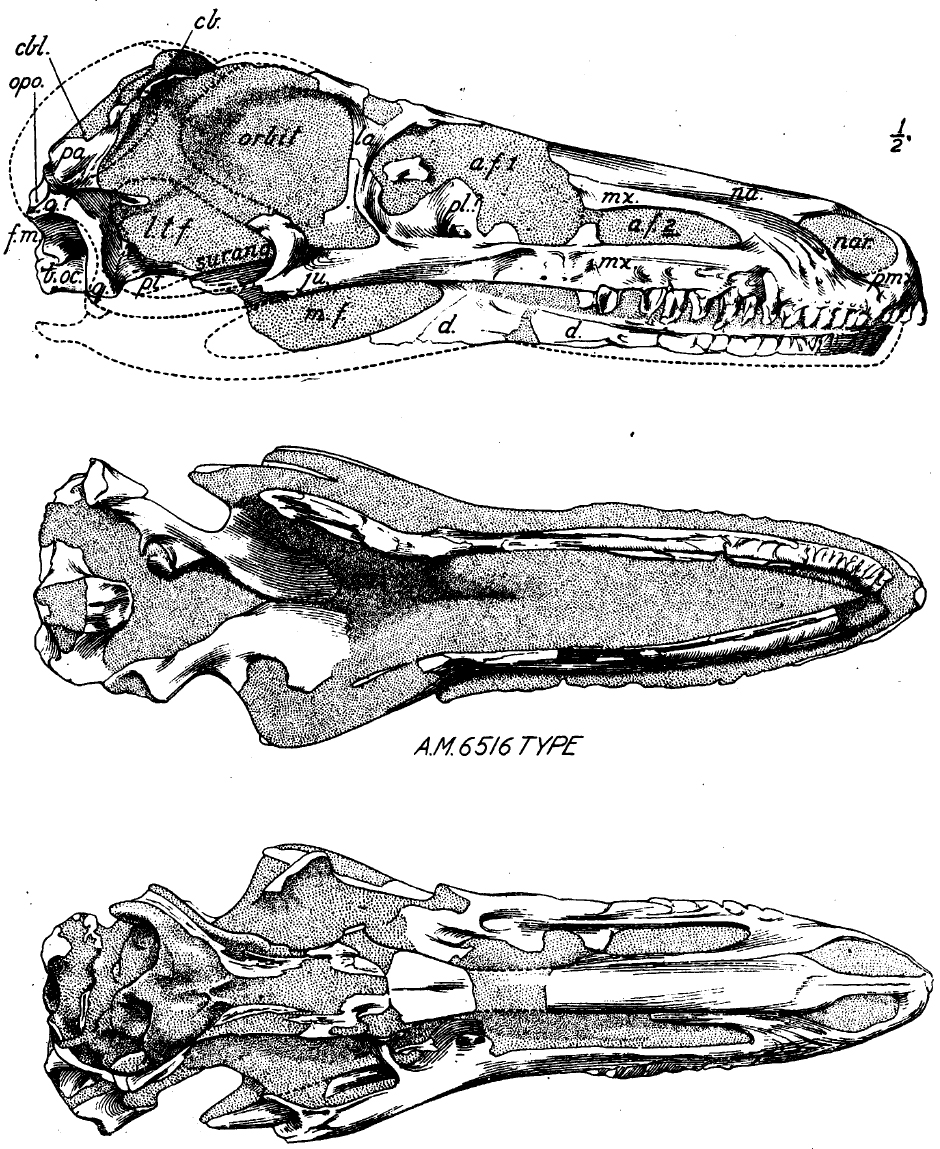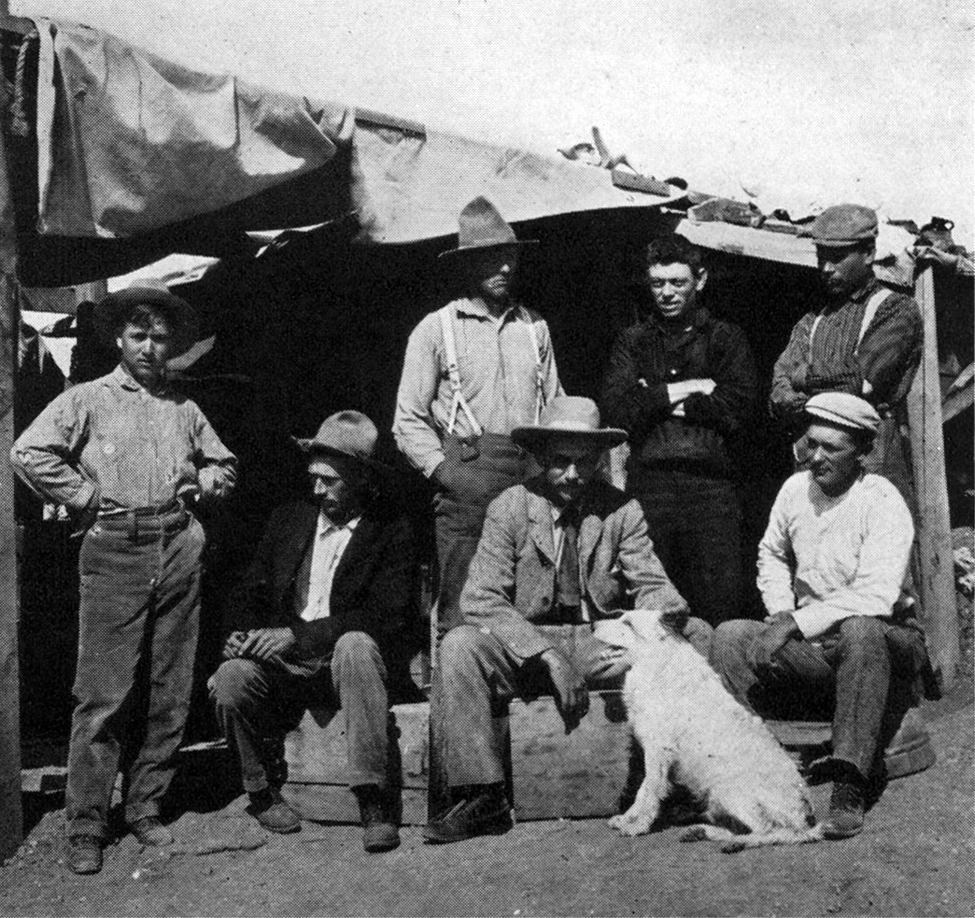|
Djadochta Formation
The Djadochta formation (sometimes transcribed and also known as Djadokhta, Djadokata, or Dzhadokhtskaya) is a highly fossiliferous geological formation in Central Asia, Gobi Desert, dating from the Late Cretaceous period, about 75 million to 71 million years ago. The type locality is the Bayn Dzak locality, famously known as the Flaming Cliffs. Reptile (including dinosaur) and mammal remains are among the fossils recovered from the formation. Excavation history The Djadochta formation was first documented and explored—though only a single locality—during paleontological expeditions of the American Museum of Natural History in 1922–1925, which were part of the Central Asiatic expeditions. The expeditions were led by Roy Chapman Andrews, in company of Walter Willis Granger as chief paleontologist and field team. The team did extensive exploration at the Bayn Dzak (formerly Shabarakh Usu) region, which they nicknamed flaming cliffs, given that at sunset the ... [...More Info...] [...Related Items...] OR: [Wikipedia] [Google] [Baidu] |
Campanian
The Campanian is the fifth of six ages of the Late Cretaceous epoch on the geologic timescale of the International Commission on Stratigraphy (ICS). In chronostratigraphy, it is the fifth of six stages in the Upper Cretaceous Series. Campanian spans the time from 83.6 (± 0.2) to 72.1 (± 0.2) million years ago. It is preceded by the Santonian and it is followed by the Maastrichtian. The Campanian was an age when a worldwide sea level rise covered many coastal areas. The morphology of some of these areas has been preserved: it is an unconformity beneath a cover of marine sedimentary rocks. Etymology The Campanian was introduced in scientific literature by Henri Coquand in 1857. It is named after the French village of Champagne in the department of Charente-Maritime. The original type locality was a series of outcrops near the village of Aubeterre-sur-Dronne in the same region. Definition The base of the Campanian Stage is defined as a place in the stratigraphic ... [...More Info...] [...Related Items...] OR: [Wikipedia] [Google] [Baidu] |
In Situ
is a Latin phrase meaning 'in place' or 'on site', derived from ' ('in') and ' ( ablative of ''situs'', ). The term typically refers to the examination or occurrence of a process within its original context, without relocation. The term is used across many disciplines to denote methods, observations, or interventions carried out in their natural or intended environment. By contrast, ' methods involve the removal or displacement of materials, specimens, or processes for study, preservation, or modification in a controlled setting, often at the cost of contextual integrity. The earliest known use of ''in situ'' in the English language dates back to the mid-17th century. In scientific literature, its usage increased from the late 19th century onward, initially in medicine and engineering. The natural sciences typically use methods to study phenomena in their original context. In geology, field analysis of soil composition and rock formations provides direct insights into Earth' ... [...More Info...] [...Related Items...] OR: [Wikipedia] [Google] [Baidu] |
Fighting Dinosaurs
The Fighting Dinosaurs is a fossil Zoological specimen, specimen which was found in the Late Cretaceous Djadokhta Formation of Mongolia in 1971. It preserves a ''Protoceratops andrewsi'' (a ceratopsian dinosaur) and ''Velociraptor mongoliensis'' (a dromaeosaurid dinosaur) trapped in combat between 75 million and 71 million years ago and provides direct evidence of predatory or agonistic behaviour in non-Bird, avian dinosaurs. The specimen has caused much debate as to how both animals came to be preserved together with relative completeness. Several hypotheses have been proposed, including a drowning scenario, burial by either dune collapse or sandstorm, or alternatively they were not buried simultaneously. History of discovery From 1963 to 1971, Polish People’s Republic, Polish-Mongolian People’s Republic, Mongolian paleontological expeditions were carried out in the Gobi Desert with the objective of fossil-finding. The expedition of 1971 visited several localities of the Dj ... [...More Info...] [...Related Items...] OR: [Wikipedia] [Google] [Baidu] |
Henry Fairfield Osborn
Henry Fairfield Osborn, Sr. (August 8, 1857 – November 6, 1935) was an American paleontologist, geologist and eugenics advocate. He was professor of anatomy at Columbia University, president of the American Museum of Natural History for 25 years and a cofounder of the American Eugenics Society. Among his significant contributions include naming the dinosaurs ''Tyrannosaurus'' and ''Velociraptor'', his widely used system of names for dental cusps of mammalian teeth, as well as his research on fossil proboscideans (elephants and their extinct relatives). Osborn was one of the most well known scientists in the United States during his own lifetime, “second only to Albert Einstein", and was a prominent public advocate for the existence of evolution. Active during the eclipse of Darwinism, Osborn was a prominent opponent of natural selection as a mechanism of evolution, favouring the now discredited orthogenesis theory of which he was one of the most prominent advocates. In a ... [...More Info...] [...Related Items...] OR: [Wikipedia] [Google] [Baidu] |
Velociraptor
''Velociraptor'' (; ) is a genus of small dromaeosaurid dinosaurs that lived in Asia during the Late Cretaceous epoch, about 75 million to 71 million years ago. Two species are currently recognized, although others have been assigned in the past. The type species is ''V. mongoliensis'', named and described in 1924. Fossils of this species have been discovered in the Djadochta Formation, Mongolia. A second species, ''V. osmolskae'', was named in 2008 for skull material from the Bayan Mandahu Formation, China. Smaller than other dromaeosaurids like ''Deinonychus'' and '' Achillobator'', ''Velociraptor'' was about long with a body mass around . It nevertheless shared many of the same anatomical features. It was a bipedal, feathered carnivore with a long tail and an enlarged sickle-shaped claw on each hindfoot, which is thought to have been used to tackle and restrain prey. ''Velociraptor'' can be distinguished from other dromaeosaurids by its long and low skull, with an ... [...More Info...] [...Related Items...] OR: [Wikipedia] [Google] [Baidu] |
Saurornithoides
''Saurornithoides'' ( ) is a genus of troodontid maniraptoran dinosaur, which lived during the Late Cretaceous period. These creatures were predators, which could run fast on their hind legs and had excellent sight and hearing. The name is derived from the Greek stems ''saur~'' (lizard), ''ornith~'' (bird) and ''eides'' (form), referring to its bird-like skull. History of discovery Originally, only one or possibly two individuals of ''Saurornithoides'' were known, closely associated within the same layer of the Djadochta Formation of Mongolia. The fossils were found on 9 July 1923 by a Chinese employee of an American Museum of Natural History expedition, Chih. The material contained a single skull and jaw in association, and vertebrae, a partial pelvis, hindlimb and foot associated nearby. More bones were initially included but later shown to belong to ''Protoceratops''. Henry Fairfield Osborn at first intended to name the animal "Ornithoides", the "bird-like one", and in 1 ... [...More Info...] [...Related Items...] OR: [Wikipedia] [Google] [Baidu] |
Protoceratops
''Protoceratops'' (; ) is a genus of small protoceratopsid dinosaurs that lived in Asia during the Late Cretaceous, around 75 to 71 million years ago. The genus ''Protoceratops'' includes two species: ''P. andrewsi'' and the larger ''P. hellenikorhinus''. The former was described in 1923 with fossils from the Mongolian Djadokhta Formation, and the latter in 2001 with fossils from the Chinese Bayan Mandahu Formation. ''Protoceratops'' was initially believed to be an ancestor of ankylosaurians and larger ceratopsians, such as ''Triceratops'' and relatives, until the discoveries of other protoceratopsids. Populations of ''P. andrewsi'' may have evolved into ''Bagaceratops rozhdestvenskyi'' through anagenesis. ''Protoceratops'' were small ceratopsians, up to long and around in body mass. While adults were largely quadrupedal, juveniles had the capacity to walk around Facultative bipedalism, bipedally if necessary. They were characterized by a proportionally large skull, short and s ... [...More Info...] [...Related Items...] OR: [Wikipedia] [Google] [Baidu] |
Oviraptor
''Oviraptor'' (; ) is a genus of oviraptorid dinosaur that lived in Asia during the Late Cretaceous period. The first remains were collected from the Djadokhta Formation of Mongolia in 1923 during a paleontological expedition led by Roy Chapman Andrews, and in the following year the genus and type species ''Oviraptor philoceratops'' were named by Henry Fairfield Osborn. The genus name refers to the initial thought of egg-stealing habits, and the specific name was intended to reinforce this view indicating a preference over ceratopsian eggs. Despite the fact that numerous specimens have been referred to the genus, ''Oviraptor'' is only known from a single partial skeleton regarded as the holotype, as well as a nest of about fifteen eggs and several small fragments from a juvenile. ''Oviraptor'' was a rather small feathered oviraptorid, estimated at long with a weight between . It had a wide lower jaw with a skull that likely had a crest. Both upper and lower jaws were toothless ... [...More Info...] [...Related Items...] OR: [Wikipedia] [Google] [Baidu] |
Flaming Cliffs
The Flaming Cliffs site (also known as Bayanzag, Bayn Dzak) ( ''rich in saxaul''), with the alternative Mongolian name of (''red cliffs''), is a region of the Gobi Desert in the Ömnögovi Province of Mongolia, in which important fossil finds have been made. It was given this name by American paleontologist Roy Chapman Andrews, who visited in the 1920s. The area is most famous for yielding the first discovery of dinosaur eggs. Other finds in the area include specimens of ''Velociraptor'' and eutherian mammals. It exposes rocks of the Djadochta Formation. It is illegal to remove fossils from the area without appropriate permits. The nickname refers to the red or orange color of the sandstone cliffs (especially at a sunset). Dinosaur bones/fossils The following are dinosaur fossils that have been found in the Flaming Cliffs. Theropods: *Maniraptorans: '' Archaeornithoides'', ''Velociraptor'', ''Saurornithoides, Oviraptor'' Ornithischians *Ceratopsians: ''Protoceratops'' * Anky ... [...More Info...] [...Related Items...] OR: [Wikipedia] [Google] [Baidu] |
Walter Willis Granger
Walter Willis Granger (November 7, 1872 – September 6, 1941) was an American vertebrate paleontologist who participated in important fossil explorations in the United States, Egypt, China and Mongolia. Early life and career Born in Middletown Springs, Vermont, Granger was the first of five children born to Charles H. Granger, an insurance agent and veteran of the American Civil War, and Ada Haynes Granger. Granger developed an early interest in taxidermy; and in 1890, at age 17, he obtained a job working as a taxidermist with a friend of his father's at the American Museum of Natural History in New York City. Working in the field with the museum's expeditions in the American West in 1894 and 1895, Granger became interested in hunting fossils. In 1896, he joined the museum's Department of Vertebrate Paleontology. In 1897, on an expedition to Wyoming, he discovered Bone Cabin Quarry near Laramie. Over the next eight years, the site yielded the fossils of 64 dinosaurs ... [...More Info...] [...Related Items...] OR: [Wikipedia] [Google] [Baidu] |
Roy Chapman Andrews
Roy Chapman Andrews (January 26, 1884 – March 11, 1960) was an American explorer, adventurer, and Natural history, naturalist who became the director of the American Museum of Natural History. He led a series of expeditions through the politically disturbed China of the early 20th century into the Gobi Desert and Mongolia. The expeditions made important discoveries and brought the first-known fossil dinosaur Dinosaur egg, eggs to the museum. Chapman's popular writing about his adventures made him famous. Biography Early life and education Andrews was born on January 26, 1884, in Beloit, Wisconsin. As a child, he explored forests, fields, and waters nearby, developing marksmanship skills. He taught himself taxidermy and used funds from this hobby to pay tuition to Beloit College. After graduating, Andrews applied for work at the American Museum of Natural History in New York City. He so much wanted to work there that after being told that there were no openings at his level, A ... [...More Info...] [...Related Items...] OR: [Wikipedia] [Google] [Baidu] |









